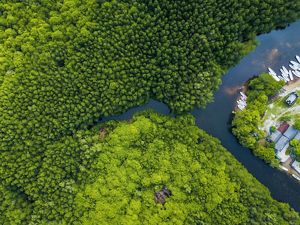The Sundarbans is the largest mangrove forest in the world spanning 9,630 km² across the borders of West Bengal, India, and Bangladesh. It is the world’s largest delta formed by the river Ganges, Brahmaputra, and Meghna. A large part of Sundarbans is recognized as Ramsar Site, wetlands of international importance, and the protected areas on the Indian side has been declared as a UNESCO World Heritage Site since 1987.
Millions of people are dependent on the Sundarbans for sustainable livelihoods. They get protection from storms, cyclones, tidal surges, and sea water intrusion and flooding. The Indian Sundarbans mangroves, particularly in non-protected regions, currently face many threats that affect their ecological integrity. The threats include exposure to environmental hazards like cyclones, storms, rising sea levels, exploitation of natural resources, unsustainable agriculture and aquaculture practices, reduced freshwater supply, stress induced by air pollution, loss of land due to erosion, depletion of crucial marine resources including diminishing fish population.

With support from Volvo for Life Funds, Nature Conservancy in India aims to restore 100ha in addition to monitoring 60 ha of previously initiated degraded mangrove habitat (not restoration initiative) areas of the Indian Sundarbans in line with the MISHTI initiative of the Government of India.
With every 100 hectares restoration 4624.2 to 6165.6 tCO2e (tonnes of carbon dioxide) per HA each can be sequestered annually. The restoration will offer improved protection and livelihood opportunities with regained mangrove shields along the settlement shorelines. The restoration project will help in strengthening the coastal community livelihood like, involving them in restoration activities, training them in sustainable aquaculture and sustainable harvesting.
Quote: Dr. Anjali Acharya
Protecting the Sundarbans is not just about conserving a unique ecosystem; it is about safeguarding millions of lives and species combating climate impact, and preserving one of the world’s largest vital natural carbon sinks by unlocking the potential of blue-carbon for the region.
Studies have indicated that the blue carbon ecosystems of India could have a collective carbon stock of 67.35 Tg C (mangroves, seagrass, and salt marsh accounting for 67 Tg C, 0.0630 Tg C, and 0.0049 Tg C, respectively) and the green payments against the blue carbon ecosystems of India can be as high as ~ 9.6 billion US $, whereas the social cost of carbon sequestered by these ecosystems can vary between 0.47 and 5.43 billion US $.
With India’s vast coastline (>7500 Km) and emerging challenges of climate change on coastal areas resulting in coastal erosion, extreme weather events, vulnerabilities of livelihoods of coastal communities, it becomes imperative to explore blue carbon to its fullest potential. Thus, Nature Conservancy in India is creating an enabling condition for “mangrove restoration and blue carbon opportunities in India” by bringing together multi-stakeholders from India’s mangrove ecosystem across coastal states of India.



